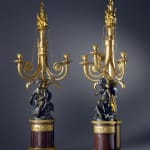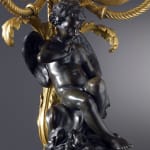François Rémond (attributed to)
Provenance
From a distinguished collector.
Literature
Peter Hughes, "The Wallace Collection Catalogue of Furniture" 1996, Vol. III, pp. 1264-71, no. 250, (F140-1), illustrating and describing a pair of almost identical candelabra in the Wallace Collection, London.
A magnificent pair of Louis XVI gilt and patinated bronze three-light candelabra attributed to François Rémond after a model by Etienne Falconet and almost certainly supplied by the marchand-mercier Dominique Daguerre, one with a patinated figure of Cupid and the other of the seated Psyche, each seated on a rock beneath a central shaft with acanthus below and issuing scrolling and spiral-fluted candle branches surmounted by a flaming torch with chains linking the platform to volutes above the scrolled branches, each figure upon a gilt bronze mounted bow-fronted rouge griotte marble base with a relief-cast panel of putti, the plinth base edged with beading and stiff leaves
Paris, date circa 1785
Height 99 cm. each.
These magnificent candelabra are almost identical to a pair previously in the collection of the 4th Marquess of Hertford by 1865, which are now in the Wallace Collection. Both Christian Baulez and Peter Hughes attribute the candle branches to the renowned ciseleur-doreur François Rémond (1747-1812) and date the design to circa 1785, on the basis that the twisted branches are typical of his production at this period such as those on a pair of three and two-light wall-lights attributed to Rémond at Château de Fontainebleau, which originally had chains linking the volutes above the arms to the platform near the tops. They also closely compare with candle branches surmounted by flaming torches on a set of four five-light candelabra, which again are attributed to Rémond and are in the Wallace Collection (ibid. pp. 1271-6, no. 251 (F142-7).
The plaster model of Cupid, known as L'Amour Menaçant by the sculptor Etienne Falconet (1716-91) was exhibited at the Salon in 1755 and the marble, commissioned by Madame de Pompadour, two years later. In 1761 Falconet made a pendant representing Psyche, which was shown at the Salon under the title Une Esquisse représentant une Petite Fille qui Cache l'Arc de L'Amour. The two figurines were modelled in biscuit porcelain by the Sèvres Manufactory; between 1761 and 1770 no fewer than 230 pairs were sold and continued in popularity throughout the century.
Since Falconet's name was not cited in Rémond's daybook it is assumed that the present bronze figures were cast and chased by another Parisian bronzier working in collaboration with Rémond under the orders of Dominique Daguerre. It is interesting to note that a pair of candelabra of this model was sold by Daguerre at Christie's in London on 25th March 1791, lot 53. Similar models of the candelabra include those almost certainly supplied by Daguerre to the 1st Earl of Harewood or Edward, Viscount Lascelles, which are now at Harewood House. One can also cite another pair with bleu turquin pedestals inset with Sarrancolin marble panels, probably supplied by Daguerre to Orlando Bridgeman, 1st Earl of Bradford for Weston Park, Shropshire. A very similar pair was in the Beresford-Hope Collection, sold by Christie's, London, 12-14th May, 1886, lot 387 and another in the Baron Nathaniel de Rothschild Collection in Vienna. Another pair with griotte pedestals acquired from the Cavendish-Bentinck Collection was in the Dutasta sale in 1926 held at Galerie Georges Petit, Paris, 3-4th June 1926, lot 103, while another pair was in Lord Biddulph's collection in 1937.
François Rémond was one of the leading Parisian fondeurs during the latter years of the eighteenth and early nineteenth centuries. Received as a maître in 1774, he worked extensively for Dominique Daguerre but also enjoyed lavish patronage from members of the French court including Marie-Antoinette, the comte d'Artois, the duc de Penthièvre and the comte d'Adhémar.



